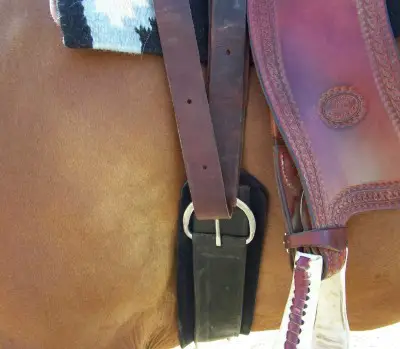Last Updated on August 21, 2023 by Allison Price
To ensure that every ride is safe and enjoyable, brush up on your front-cinch knowledge.
A Western saddle must have a front cinch. Without it, the saddle will not stay on. Your cinch is held in place by adjustable leather or nylon straps or latigos. It can withstand the repeated forces of horses’ movements. A faulty or badly fitted front cinch could easily cause a horse to become a wreck. Here are some tips to help you choose the right front cinch and how to fit it correctly.
[READ: No More Saddle-Sore]
Materials
There are three main materials that can be used for cinches: mohair, fleece and neoprene. Each material has its pros and cons and each one has its own uses.
Fleece. The fleece is the most gentle against horse skin. It can clump and become matty if it isn’t well maintained. This material has more slip than other materials. To keep your saddle in place, you will need to tighten it against your horse’s girth. The material is also dense so your horse may miss cues if it touches him instead.
Mohair. The most traditional and breathable. Mohair is more breathable than fleece and can be dried faster than fleece. This makes it easier to maintain as it doesn’t retain water. Mohair is not as easy to clean than other options so it may not be the most time-saving option.
Neoprene. It is more durable than other materials and easy to clean. Because it dries quickly, you can spray directly with antifungal solution or disinfectant to make it easier to maintain. Neoprene can be too hot and cause skin irritation in horses with sensitive skin. Look for a neoprene tie that allows heat to escape.
[READ: Cinch Pressure]
Sizing
Western cinches typically measure between 26 and 34 inches in increments of 2 inches. Place an unrigged saddle on the back of your horse to measure. Place a soft measuring tape under the saddle’s girth to determine the distance between the dee rings. For example, if the tape measures 40 inches between the dee rings, your cinch size is 32 or 34. You can adjust your tape before mounting up, and you won’t run out holes in your latigos.
Take care
Regular cleaning is necessary for maintaining the front cinches. Equipment can be damaged by sweat, hair, mud and moisture over time. This could lead to skin conditions such as girth itching. After a sweaty session, let your cinch dry completely or spray it down before you store. You should clean your cinch thoroughly if you notice dirt or caked hair.
Take your fleece and rip it in half. Then, put it in the washer. It will be in near-new condition if you brush it once it is dry.
Hand-wash mohair. Your machine could be damaged by the hardware. Rinse your machine with mild soap and water.
Neoprene is easy to clean. You can rinse it with a hose and spray with disinfectant. Then, dry it. You can also remove it from the saddle and wash it like fleece.
Styles
The style of cinch depends on the purpose of your ride, your personal preference and the best fit for you horse.
Straight. This is the most popular style and the best for most riders. (See page 38, “Fleece”) It is versatile and can be used for general riding and most disciplines.
Roper. The cinch is wider at the middle (see “Mohair”) photo on page 38), giving the saddle more secure surface. It’s also used for high-performance riding and non-roping. It provides safety for horses with low shoulders and helps keep your saddle from rolling.
Contoured. The style tapers or cuts back near the horse’s armspits to prevent chaffing. For events that require a wide range of motion such as Western dressage and trail challenges, contoured cinches can be very useful.
Double-layer. These, as the name implies, are double-layered (mostly with mohair). This layer provides extra support for material and is usually made in a roper-style tapered shape.
[READ: Cinch up Your Saddle Right]
Longevity
A well-maintained cinch will last. Visible fraying, matting or cracking (such a with neoprene), as well as damage to hardware, are signs that it is time to replace the cinch. Replace your cinch as needed. It is possible to prevent most damage from occurring from inadequate maintenance or spurs or snags along the trail.
A straight cinch should be placed near the horse’s shoulder. This position keeps your saddle securely on the withers.
Although it might seem costly to replace a cinch that is “alright,” the savings are not worth the risk. You’ll regret not replacing your front cinch sooner if it breaks while you ride, injuring yourself or your horse. Latigos are also subject to this rule. To make sure they are in top condition, you should inspect them every so often.
Additional
Each front cinch is equipped with two smaller dee rings at each end of the girth. Attaching the breastcollar is done by the front-facing dee. On both sides of your setup, cinch with equal space between the saddle and cinch. You should center the dee, not place it between your horse’s shoulder and his girth.
Your back-facing dee is your back cinch hobble. The hobble helps to keep your back cinch (if it exists) in place so that it doesn’t slip onto sensitive areas like the flank.



